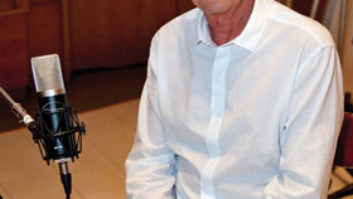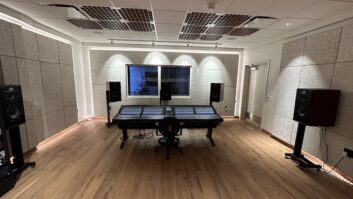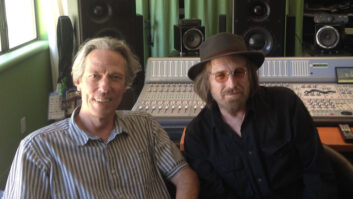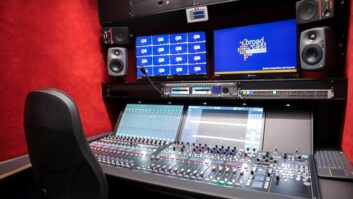The FCC’s scheduled 2009 “turn-off” date for analog terrestrial television for U.S. consumers elicits a sigh of relief from major networks and independent broadcasters. There’s also a natural wave of optimism for the equipment suppliers, who foresee a buoyant future supplying audio and video hardware to those who will be upgrading installations with standard- and high-definition digital technologies.
Any upgraded or new broadcast/post facility needs a technical infrastructure that will allow for transferring and distributing digital data throughout the site. High-speed servers, multiport routers and other distribution components, using real-time delivery or on-demand streaming via IP-based networks, are replacing balanced/unbalanced audio cables. With data rates in the Gbit range, twisted-pair copper is being replaced with co-ax, fiber and other signal-distribution schemes, including various Ethernet-based network topologies. Planning for future needs is an essential part of a successful facility design.
MANY APPROACHES, FEW STANDARDS
Even with some 1,550 U.S. stations delivering SD and HD programming, there’s no consensus regarding which digital topology/delivery scheme makes the most sense; each has its pluses and drawbacks. ABC’s DTV network provides affiliates with a 2-channel MPEG (Dolby Pro Logic Lt-Rt) and a 640Kbit/sec AC-3/Dolby Digital stream for HD 5.1-channel broadcasts using a “mezzanine” (a lossless/near-lossless system inserted at the front end of the chain) compression system. To simplify plant timing, routing and storage considerations, the CBS DTV network affiliates receive Dolby E — encoded multichannel audio — 5.1 surround and stereo — plus an additional 2-channel Lt-Rt AES-format pair via a mezzanine compression scheme.
NBC’s DTV network delivers audio to its affiliates via MPEG compression within a proprietary mezzanine compression. Here, downstream stations receive up to eight uncompressed PCM channels via four AES-format pairs that comprise, at minimum, a stereo or Lt-Rt/Pro Logic signal on the first pair and, if available, a 5.1-channel program on the remaining three pairs. The Fox DTV network affiliates get an AC-3/Dolby Digital signal at 448 kbps to ensure full-time 5.1-channel audio feeds during prime-time HD programming.
PBS distributes a standard 19.39MBit/sec ATSC transport stream to its DTV-capable affiliates. Using this scheme, any affiliate station equipped with a modulator, RF amplifier and antenna can broadcast HD with 5.1 channels of audio, but, as with Fox affiliates, inserting local programming becomes complicated.
Of primary importance to facilities contemplating the move to HDTV is the choice of compressed or uncompressed audio and whether to implement an embedded or non-embedded scheme. The former normally involves the use of Dolby E encoding or a similar scheme to squeeze eight channels (in Dolby’s case) into a standard AES-format stereo pair and route it within the plant like a normal digital signal. According to Scott Griffin, VP of engineering at The Systems Group, “That choice depends on media preparation: If the network post-produces its content and delivers it to other in-house groups, Dolby E makes a lot of sense to save data bandwidth and ensure mixing/switching integrity.
“If the majority of material comes from out-of-house,” Griffin continues, “it makes more sense to remain uncompressed, delivering un-encoded audio channels to allow flexible audio channel manipulation and compatibility with diverse channel maps. With increasing data bandwidth available via server-based networks and other delivery mechanisms, data compression is less of a concern. Emerging requirements for multilingual Secondary Audio Program [SAP] and Descriptive Video Service [DVS] channels lend themselves better to un-encoded multichannel. An added bonus with this approach is that encode/decode passes are minimized.”
Media transfer can speed — or hinder — workflow. System designers need to identify where file transfers between high-capacity servers can replace real-time streams, and analyze areas in which non-real-time file retrieval might work instead of real-time data stream processing/mixing.
Point-to-point signal routing throughout an HD-compliant facility can be streamlined using embedded audio schemes, where up to 24-bit/48kHz uncompressed PCM signals can be multiplexed with an SDI or HD-SDI digital video signal. Such transport schemes simplify cabling and infrastructure, particularly when used with high-capacity routers from brands such as Grass Valley Group, NVISION, Miranda, Utah Scientific, Quartz and Evertz that accommodate high-bandwidth signals up to 1.5 GBits/sec. For added flexibility, different models can handle on-the-fly embedding or video signals with pre-embedded audio, so broadcasters and post facilities can mix and match digitized analog video/audio with digital video and embedded audio. Using fiber-optic connections, system configurations can range from simple point-to-point and point-to-multipoint to large-scale video networks accommodating multiple add/drop sites — often with bidirectional data flow — for applications such as studio-to-studio and studio-to-transmitter links.
THE AOIP ALTERNATIVE
According to Griffin, IP-based topologies are becoming increasingly popular. “WGBH, PBS’ flagship Boston station, may be implementing an audio-over-IP [AOIP] system, for example,” he says. The BBC World newsroom is currently conceived with 40 2-channel digital audio workstations that will ingest, stream and file-exchange audio data over an IP network. Users will benefit from desktop AOIP access to as many as 30 news-gathering feeds via a plug-in media player front end and file-management tools allowing clip integration into desktop edit sessions. According to Griffin, AOIP “involves a relatively simple infrastructure,” with a simple physical layer and a complex virtual layer.
NBC’s Studio 8H production control room in Rockefeller Center, New York City. 8H is the home of Saturday Night Live, offered in HDTV.
For larger network operations, a more sophisticated topology will be required. “NBC Universal is designed to route and brand more than 30 channels of SD and HD-SDI signals, while Viacom” — which owns CBS Network, MTV, Showtime, Infinity Broadcasting and other outlets — “handles 20 release channels in a single operations monitoring and control room,” Griffin points out.
FLEXIBILITY IS EVERYTHING
Remote trucks require flexible internal communications and connectivity. “These are further complicated with surround sound,” says Griffin. A recently completed remote truck for MTV Networks is a good example of this enhanced flexibility. This type of truck often includes an optical transport layer for HD, linked through multiple routers using embedded audio within both SDI and HD-SDI signals. “To further simplify cabling, we are also looking at optical connections for remote talent positions. This way, we can flexibly interconnect three or four studios or control rooms using easy-to-re-rig fiber links.”
Efficient and easy-to-understand monitoring systems for intelligently switching between multiple sources of multichannel playback at multiple operator positions is essential. “Viacom, for example, has five operators providing quality control for up to 20 HD/SD channels and need to switch multiple sources in varying combinations to the monitor loudspeakers,” Griffin notes. “We developed a system providing multiple functions, including phase check, mute, solo, 2-channel modes and fold down of a 5.1-channel input to selected loudspeakers.”
An excellent example of an intermixed audio infrastructure occurs at NBC Universal’s New York studio complex in Manhattan, which provides production facilities for Saturday Night Live, offered weekly in HDTV with 5.1 surround. “NBC’s studio and plant distribution scheme currently uses two ways to move audio signals back and forth within the digital domain,” says Jim Starzynski, principal engineer at NBC Universal Advanced Technology. “For productions and distribution of high-definition signals within the NBC plant, audio is transported on an HD-SDI plant-wide router capable of 16 channels of embedded audio.” Multiplexing is handled by Miranda mux and demux equipment, with installations currently outfitted to use eight discrete channels — two complete audio groups expandable to four groups or 16 channels. All signals are referenced to a 48kHz sample rate; resolution can be either 20 or 24 bits.
“Dolby E is used by our entertainment and sports productions for multichannel sound delivery and for live remotes from the field,” Starzynski says. Dolby E deliverables are decoded at plant entry, and the discrete audio and metadata are multiplexed into HD-SDI for the plant router. All internal plant multichannel sound distribution is discrete.
For SDI connections, NBC uses multiple plant routers capable of four discrete digital channels — one SDI group — running at 20-bit/48kHz. “SD and HD worlds are connected via digital conversion tielines between the routers,” says Starzynski. HDTV multichannel sound is automatically downmixed to 2-channel Lt-Rt for SD use. “Second audio program and video-descriptive service are directly mapped to the proper distribution channel from HD to SD, and vice versa. Downmixes and channel assignments between formats are accomplished with Miranda XVP multiprocessors.”
To ensure sample-accurate sync between video and audio sources, NBC-Universal New York uses redundant sync-pulse generators, which output multiple timing signals, the most critical being 29.97Hz analog video color black, which is distributed to all plant areas, becoming the ultimate reference for all equipment.
Most signals are carried around the facility on precision co-ax cabling. “There is no 110-ohm digital audio distribution,” Starzynski stresses. “Fiber is used for long runs from Rockefeller Plaza locations — like The Today Show — into the 30 Rock plant.” Sources originating in production studios are routed through an audio/video control room with an output that directly feeds SD or HD routers.
For NBC-Universal, all HD studio outputs are discrete AES-format audio signals embedded into an HD-SDI signal that feeds the plant router. “Channel mapping is the SMPTE standard of L, R, C, LFE, Ls and Rs on channels 1 through 6,” says Starzynski. “We have reserved channels 7 and 8 for SAP and DVS. HD-SDI channels 9 and 10 have been reserved ultimately for Lt-Rt, while stereo-only productions use channels 1 and 2. A Miranda cross-converter simultaneously generates a standard-definition digital data stream from the HD production format, with a metadata-enabled aspect ratio control producing a “center-cut” or “letterbox” 4:3 video image with a companion downmixed 5.1-channel-to-Lt-Rt audio for the SD audience.
“Everything for SNL is handled in 5.1-channel,” stresses David Lazecko, NBC-Universal’s director of studio engineering. “We pass 5.1-channel streams, along with Lt-Rt and metadata, through an HD router that handles 256×256 sources with 16 channels of embedded audio. We use eight for the show that pass to a hard disk recorder. We also have a large Apple SAN that handles our interlinked Final Cut Pro systems that are used to pre-produce and edit the show [for syndication].” The SAN handles uncompressed HD video and uncompressed 24/96 audio; the pre-record music systems run at 96 kHz for enhanced audio quality, with files being down-sampled for the live show. Hard disk recorders or Sony HDCAM-SR video machines, both of which accommodate multichannel audio and VANC data, handle master recordings for Saturday Night Live.
ASCENT MEDIA
A leading supplier of audio post services for TV and film, Ascent Media operates 70 facilities in Southern California, New York, London, Singapore and other locations. In Los Angeles, Ascent Media Creative Sound Services’ post sound houses — clustered around Hollywood, Burbank and The Westside — are interlinked via high-speed data highways. “All media is delivered from central or local servers,” advises Bill Johnston, Ascent Media’s senior VP of engineering. “We do not work with tape much anymore. Instead, we have placed a focus on providing Gigabit IP-based networks that can deliver audio and video files from our Apple Xserve and Xserve RAID high-performance servers.”
Ascent typically delivers files ahead of a session to server drives at a target remixing stage or pre-production area. Reasoning that on-demand bandwidth between facilities is still impractical, the company uses a push-pull IP transport layer to transfer data in near-real time. “Starting at let’s say 8:15 a.m., we can deliver all of the sound and picture elements for a complex mix session well before 9 a.m.”
The primary backbone used by Ascent to link regional production centers is based on high-speed connections from Orbit Data Technologies that are optimized for IP transfers over long distances from Hollywood to New York and even London. “We also use Digidesign Digi Delivery to send encrypted material to our remote facilities and to outside editorial rooms,” Johnston says. “Our servers need to be highly secure, so we provide broadband IP to the Internet in selected ways; we use AFP [Apple File Protocol], which is more secure for us than conventional FTP-based transfers. We are also exploring QuickTime encryption technologies, such as MovieLok from Gallery.” Also available are Fiber 270 connections operating at 270 MBit/sec using dedicated switchers and fiber from SBC/Pacific Bell, which Ascent uses to centralize its layback rooms. For example, while posting Touchstone’s HD show Commander in Chief, Johnston explains, “Executive producer Steven Bochco likes to audition mixes in real time at our [Westside] Lantana facility while it’s being mixed in Burbank [Calif.].”
For routing real-time signals between production areas, “We use MADI-format routers if they’re provided on the front end of a digital console, but because we do not have centralized machine rooms — everything is operated locally from the dub stage or editorial room — we needed large-format routers like StageTec’s Nexus MADI-based router that Fox Studios uses ahead of its DFC digital consoles,” says Johnston. “Plain-vanilla TRS patchbays and Elco connectors are as easy to use, we find, and certainly more cost-effective than routers. Ascent has spent a lot of money on its wiring infrastructure, using fiber optic for the high-speed IP highways and AES/EBU connections for stereo pairs, and traditional analog patching where required.”
Server-based topologies can’t keep everything online 24/7, so an efficient backup and restore strategy is important. Blu-ray media offers increasing capacity; current 23GB discs are expected to be superseded by 50GB formats.
“A 50GB capacity nicely matches our workflow, with an excellent cost-per-GByte; its long-term viability looks very good,” Johnston says. Also important is an efficient and effective digital asset — management strategy to ensure that material can be tracked through final delivery. “Everything must be cataloged,” Johnston concludes. Given that a “typical” production can require 200 GB to 1 TB of audio files, including duplicates, labeling data is critical. “All file names should be human-readable, but they cannot tell us everything about their history and current status, which is why system metadata is crucial.”
Mel Lambert heads up Media&Marketing, a consulting service for audio firms.
A Mouthful of Acronyms
Anyone delving into digital television (DTV) technologies will surely be overwhelmed by incessant strings of acronyms. Here are a few that may help keep you on track.
AFP (Apple File Protocol): a method for sharing data (files or applications) over an AppleTalk network.
AOIP (Audio Over IP): a system for audio file sharing/transport that converts analog or digital audio into Ethernet packets for distribution over a Local Area Network (LAN) or Ethernet switches.
ATSC (Advanced Televisions Systems Committee): an international, non-profit organization developing voluntary standards for digital television.
DTH (Direct to Home): program distribution to consumers via satellite downlink.
DVS (Descriptive Video Service): a service that helps make television accessible to persons with visual impairment using narrative audio files that accompany the programming.
EDTV (Enhanced Definition Television): a system having a picture with at least 480 vertical scanning lines and 5.1 surround audio in the Dolby Digital format.
FTP (File Transfer Protocol): a data-sharing protocol based on standard TCP/IP Internet to move files from one computer to another.
MADI (Multichannel Audio Digital Interface): a professional standard for transmitting up to 56 channels of digital audio data over a single cable.
SAN (Storage Area Network): a network or sub-network of shared storage devices such as disks or disk arrays that are available to any user on a server.
SAP (Second Audio Program): a broadcast or tape capable of carrying an alternate audio track, typically used for a second-language soundtrack.
SDI (Serial Digital Interface): a serial digital video data stream having video and four channels of audio.
SDTV (Standard Definition Television): “old-school” television systems having less than 480 vertical scan lines and at least monaural audio — essentially the equivalent of current NTSC TV.
Goodbye Rabbit Ears
It’s been a long time coming since the first HDTVs were introduced (back in 1998), but the days of good old analog TV are coming to an end. In December 2005, the Senate passed a bill that calls for television broadcasters to cease analog broadcasts on February 17, 2009, at which point, the broadcast spectrum will be freed up for other purposes, such as wireless and public safety services.
The FCC also requires that all new television receivers include the capability to receive digital TV signals; by March 2007, all televisions are required to have built-in digital tuners. For more information, visit www.fcc.gov/cgb/consumerfacts/digitaltv.html.







